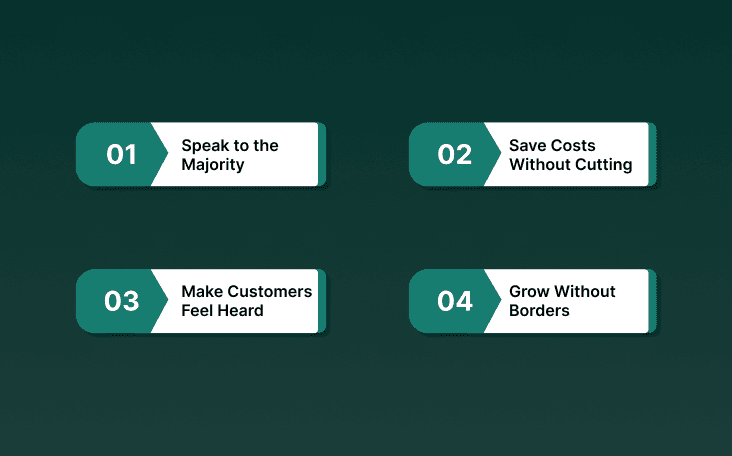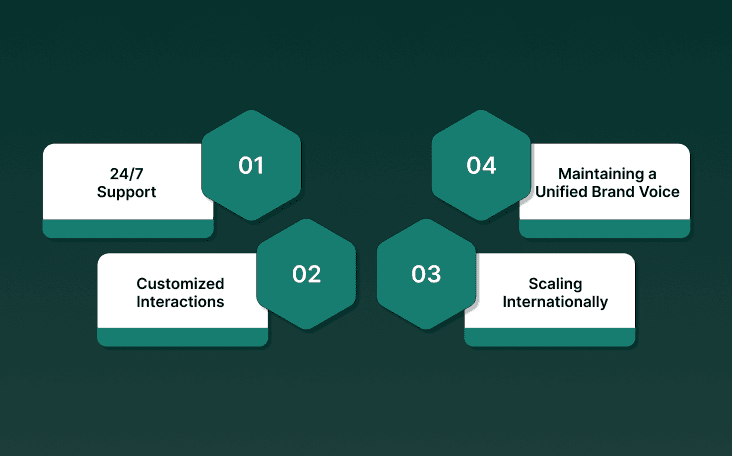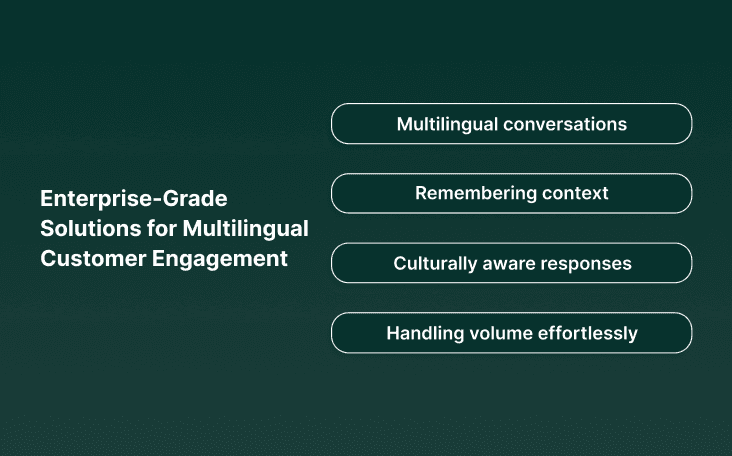How Multilingual Chatbots Drive Global Customer Connections
Explore how multilingual conversational AI agents enable seamless interactions, build customer trust, and support international business growth.

Akshat Mandloi
Updated on
December 26, 2025 at 11:28 AM
Every customer wants to feel understood, and language plays a huge role in that connection. A striking 75% of customers say they’re more likely to buy again when support is available in their native language, highlighting the importance of multilingual support.
Multilingual conversational AI is helping businesses meet this demand efficiently. By automating responses in multiple languages, companies can offer consistent and personalized experiences across different markets.
This approach improves accessibility and builds stronger trust. Customers are more likely to engage and stay loyal when they can communicate comfortably in their own language, opening doors to a wider audience.
Breaking language barriers also drives global growth. By reaching new markets and connecting with diverse customers, businesses can expand their presence. This article explores how multilingual chatbots and conversational AI enable companies to achieve accessibility, trust, and international reach.
Key Takeaways:
Global Reach Requires Language Understanding: Multilingual conversational AI enables businesses to communicate effectively with non-English-speaking customers, promoting trust and accessibility.
Efficiency and Engagement: Chatbots provide 24/7 support, handle multiple languages, and maintain a consistent brand voice, improving customer satisfaction and operational efficiency.
Industry Impact: Key sectors like e-commerce, travel, healthcare, and HR benefit from faster responses, higher engagement, and reduced costs through multilingual AI interactions.
Best Practices and Challenges: Success requires prioritizing key languages, localizing culturally, using region-specific data, and continuously monitoring while managing language complexity and compliance.
What Is Multilingual Conversational AI?
Multilingual conversational AI is an intelligent system that understands and responds in multiple languages. It goes beyond literal translation, interpreting context and recognizing user intent to keep conversations coherent. It adapts to complex queries while maintaining relevant and consistent dialogue across languages.
With this understanding in place, it’s easy to see why businesses are increasingly adopting multilingual conversational AI to connect with global audiences.
Why Businesses Need Multilingual Conversational AI

The internet is no longer dominated by English. It makes up just under half of online content, about 49.4%, while billions of users browse, shop, and connect in their native languages.
Multilingual conversational AI lets businesses meet these users where they are, enabling meaningful, personalized interactions. Here’s how multilingual conversational AI makes it possible:
1. Speak to the Majority
More than half of online users prefer content in a language other than English. Responding in their native tongue ensures messages are not just read, but genuinely understood, which creates a sense of inclusivity and respect for different cultures.
2. Save Costs Without Cutting Corners
Building and maintaining a multilingual support team 24/7 is expensive and time-consuming. AI can handle multiple languages at once, providing consistent, accurate responses while freeing up resources for other business priorities.
3. Make Customers Feel Heard
Customers connect better when they can express themselves naturally. Conversational AI that recognizes intent and context allows users to feel understood, which strengthens trust, encourages ongoing engagement, and nurtures long-term loyalty.
4. Grow Without Borders
Entering new markets often comes with logistical and staffing challenges. Multilingual AI enables companies to expand globally without overwhelming operational demands, allowing for personalized, smooth interactions regardless of customer location.
Also Read: Top 11 Conversational AI Platforms In 2025
By handling multiple languages, conversational AI enables chatbots to deliver consistent, personalized interactions. Let’s explore the advantages these chatbots provide.
How Multilingual Chatbots Drive Global Engagement

Global customers expect quick, uninterrupted interactions, no matter where they are or what time it is. AI-powered chatbots meet this expectation by combining round-the-clock availability with culturally aware responses. Here’s how they strengthen engagement across regions:
1. 24/7 Support
Multilingual chatbots work around the clock, so customers in different time zones can get help immediately. There’s no waiting for business hours, and every query gets a response.
This 24/7 availability makes customers feel valued and keeps engagement consistent, no matter where they are.
2. Customized Interactions for Local Contexts
These chatbots understand local expressions, slang, and cultural nuances. They adapt replies so conversations feel natural and relevant. By speaking the user’s language, not just literally but contextually, businesses create stronger connections and leave a positive impression.
3. Scaling Internationally with Ease
Expanding into new countries usually requires hiring local support teams, which is expensive and slow. Multilingual chatbots can manage large volumes of interactions across regions, helping businesses grow globally without huge operational costs or delays.
4. Maintaining a Unified Brand Voice
Even when responding in multiple languages, chatbots keep the same tone, style, and messaging. This consistency ensures that customers recognize and trust the brand, regardless of where they are or what language they speak.
Also Read: How Conversational AI Is Transforming Customer Engagement and Business Automation
Stronger engagement is only part of the story. The real value shows up in specific industries where multilingual chatbots solve pressing challenges and drive measurable results.
Where Multilingual Chatbots Deliver the Most Impact
Multilingual chatbots solve very real problems across industries where communication speed and clarity matter most. Here’s where they create the biggest difference:
Customer Support: Instant replies in a customer’s own language reduce wait times and create smoother experiences, helping customers get answers quickly without frustration.
E-commerce: Multilingual chatbots guide customers through checkout and enable smooth cross-border transactions, making shopping easier and more accessible worldwide.
Travel & Hospitality: Multilingual chatbots provide travelers with quick answers to booking and flight-related questions, helping turn stressful situations into smooth experiences.
Healthcare: Hospitals use multilingual chatbots to explain care instructions in plain terms. Studies show this raises patient engagement by about 30% and even reduces readmissions by up to 25%.
HR & Recruitment: Chatbots can automate routine candidate queries and screening tasks, speeding up the process and reducing reliance on manual effort while improving candidate experience.
Multilingual chatbots create clear value across industries, yet building them isn’t simple. Several challenges stand in the way of seamless global conversations.
Challenges in Building Multilingual Chatbots
Building chatbots that handle multiple languages goes beyond simple translation. Each language has its own quirks, slang, idioms, and cultural references that must be understood to avoid mistakes.
Low-resource languages have limited digital data, making training more difficult. Brands also need to keep their tone consistent while following privacy rules in every region.
The table below highlights these main challenges clearly.
Challenge | Example / Impact |
|---|---|
Language complexity | Dialects and slang differ (e.g., Mexican vs. Argentine Spanish), risking misinterpretation. |
Limited training data | Certain languages have small digital datasets, while AI development focuses heavily on English. |
Tone & brand identity | Literal translations may turn a friendly brand voice into blunt or overly formal wording. |
Compliance & privacy | Regional laws like GDPR or Brazil’s LGPD require strict data handling. Violations can bring heavy fines. |
Recognizing these challenges helps shape strategies for setting up AI agents that perform accurately, stay on brand, and comply with regulations.
Best Practices for Deploying Multilingual Chatbots
Deploying a multilingual chatbot successfully starts with clear priorities and careful planning. Following these practices ensures your chatbot communicates naturally, resonates with users, and contributes to effective contact center automation over time:
Focus on Critical Languages First: Begin by supporting the languages spoken by the largest segments of your audience. This approach ensures you reach the majority quickly and make the most immediate impact.
Prioritize Cultural Localization: Avoid literal translations. Adapt messages to local customs, expressions, and etiquette so conversations feel natural. Small differences in phrasing can make a big difference in how users perceive your brand.
Train on Region-Specific Data: Use real queries, slang, and common questions from each target market. Chatbots trained on localized data handle edge cases better and reduce misunderstandings, creating smoother interactions.
Implement Continuous Monitoring and Feedback Loops: Continuously track conversations and gather user feedback. This allows the chatbot to learn from errors, refine responses, and maintain high-quality interactions across all languages.
Also Read: AI Call Centers vs. Human Agents: Finding the Ideal Balance in Customer Support
Putting these best practices into action requires the right tools. Smallest.ai provides AI agents that make multilingual conversations smooth, natural, and effortless at scale.
Enterprise-Grade Solutions for Multilingual Customer Engagement

Businesses expanding globally often struggle to talk to customers in their native language without sounding robotic or losing context. Smallest.ai’s AI-driven voice agents make multilingual conversations smooth, natural, and consistent.
Here’s how they make every conversation feel seamless:
Multilingual conversations: Agents understand and respond in multiple languages without losing the meaning of the conversation.
Remembering context: AI tracks prior interactions, so every reply feels connected and relevant.
Culturally aware responses: Agents adapt phrasing and tone to match local customs and expressions.
Handling volume effortlessly: High numbers of multilingual queries are managed without needing a huge human team.
With Smallest.ai agents, businesses can engage customers in their own language, build trust, and expand globally without the usual headaches of managing multiple language teams.
Conclusion
Multilingual conversational AI opens doors to global audiences while strengthening customer trust. It ensures businesses can communicate meaningfully across languages and regions, creating connections that last.
Today, integrating these systems is a strategic move for growth. Companies using multilingual AI can expand internationally, engage diverse customers, and stay competitive in an increasingly connected world.
In practice, Smallest.ai’s real-time AI agents allow businesses to manage multilingual interactions seamlessly, maintain a consistent brand voice, and scale global customer engagement effortlessly.
Try Smallest.ai today to manage global interactions seamlessly while keeping your brand voice consistent.
FAQs
1. Can multilingual chatbots handle voice-based conversations in addition to text?
Yes. Modern chatbots can process spoken language, converting speech to text and responding in the user’s language. This is particularly useful for voice assistants, call centers, and accessibility applications.
2. How do multilingual chatbots support regional compliance and accessibility standards?
Beyond language, chatbots can be configured to meet local accessibility requirements (like screen reader compatibility) and comply with regional communication guidelines, ensuring inclusive interactions.
3. Can chatbots learn new languages over time?
Advanced conversational AI can be trained incrementally, allowing businesses to add support for new languages or dialects based on evolving customer demographics and interaction data.
4. Do multilingual chatbots improve employee productivity?
Yes. By handling routine or repetitive multilingual queries, chatbots free human agents to focus on complex tasks, improving overall team efficiency and reducing burnout.
5. Can chatbots personalize recommendations across different regions?
Yes. Multilingual AI can combine language understanding with regional data like preferences, cultural trends, and seasonal behavior to offer location-specific suggestions, promotions, or content.
Every customer wants to feel understood, and language plays a huge role in that connection. A striking 75% of customers say they’re more likely to buy again when support is available in their native language, highlighting the importance of multilingual support.
Multilingual conversational AI is helping businesses meet this demand efficiently. By automating responses in multiple languages, companies can offer consistent and personalized experiences across different markets.
This approach improves accessibility and builds stronger trust. Customers are more likely to engage and stay loyal when they can communicate comfortably in their own language, opening doors to a wider audience.
Breaking language barriers also drives global growth. By reaching new markets and connecting with diverse customers, businesses can expand their presence. This article explores how multilingual chatbots and conversational AI enable companies to achieve accessibility, trust, and international reach.
Key Takeaways:
Global Reach Requires Language Understanding: Multilingual conversational AI enables businesses to communicate effectively with non-English-speaking customers, promoting trust and accessibility.
Efficiency and Engagement: Chatbots provide 24/7 support, handle multiple languages, and maintain a consistent brand voice, improving customer satisfaction and operational efficiency.
Industry Impact: Key sectors like e-commerce, travel, healthcare, and HR benefit from faster responses, higher engagement, and reduced costs through multilingual AI interactions.
Best Practices and Challenges: Success requires prioritizing key languages, localizing culturally, using region-specific data, and continuously monitoring while managing language complexity and compliance.
What Is Multilingual Conversational AI?
Multilingual conversational AI is an intelligent system that understands and responds in multiple languages. It goes beyond literal translation, interpreting context and recognizing user intent to keep conversations coherent. It adapts to complex queries while maintaining relevant and consistent dialogue across languages.
With this understanding in place, it’s easy to see why businesses are increasingly adopting multilingual conversational AI to connect with global audiences.
Why Businesses Need Multilingual Conversational AI

The internet is no longer dominated by English. It makes up just under half of online content, about 49.4%, while billions of users browse, shop, and connect in their native languages.
Multilingual conversational AI lets businesses meet these users where they are, enabling meaningful, personalized interactions. Here’s how multilingual conversational AI makes it possible:
1. Speak to the Majority
More than half of online users prefer content in a language other than English. Responding in their native tongue ensures messages are not just read, but genuinely understood, which creates a sense of inclusivity and respect for different cultures.
2. Save Costs Without Cutting Corners
Building and maintaining a multilingual support team 24/7 is expensive and time-consuming. AI can handle multiple languages at once, providing consistent, accurate responses while freeing up resources for other business priorities.
3. Make Customers Feel Heard
Customers connect better when they can express themselves naturally. Conversational AI that recognizes intent and context allows users to feel understood, which strengthens trust, encourages ongoing engagement, and nurtures long-term loyalty.
4. Grow Without Borders
Entering new markets often comes with logistical and staffing challenges. Multilingual AI enables companies to expand globally without overwhelming operational demands, allowing for personalized, smooth interactions regardless of customer location.
Also Read: Top 11 Conversational AI Platforms In 2025
By handling multiple languages, conversational AI enables chatbots to deliver consistent, personalized interactions. Let’s explore the advantages these chatbots provide.
How Multilingual Chatbots Drive Global Engagement

Global customers expect quick, uninterrupted interactions, no matter where they are or what time it is. AI-powered chatbots meet this expectation by combining round-the-clock availability with culturally aware responses. Here’s how they strengthen engagement across regions:
1. 24/7 Support
Multilingual chatbots work around the clock, so customers in different time zones can get help immediately. There’s no waiting for business hours, and every query gets a response.
This 24/7 availability makes customers feel valued and keeps engagement consistent, no matter where they are.
2. Customized Interactions for Local Contexts
These chatbots understand local expressions, slang, and cultural nuances. They adapt replies so conversations feel natural and relevant. By speaking the user’s language, not just literally but contextually, businesses create stronger connections and leave a positive impression.
3. Scaling Internationally with Ease
Expanding into new countries usually requires hiring local support teams, which is expensive and slow. Multilingual chatbots can manage large volumes of interactions across regions, helping businesses grow globally without huge operational costs or delays.
4. Maintaining a Unified Brand Voice
Even when responding in multiple languages, chatbots keep the same tone, style, and messaging. This consistency ensures that customers recognize and trust the brand, regardless of where they are or what language they speak.
Also Read: How Conversational AI Is Transforming Customer Engagement and Business Automation
Stronger engagement is only part of the story. The real value shows up in specific industries where multilingual chatbots solve pressing challenges and drive measurable results.
Where Multilingual Chatbots Deliver the Most Impact
Multilingual chatbots solve very real problems across industries where communication speed and clarity matter most. Here’s where they create the biggest difference:
Customer Support: Instant replies in a customer’s own language reduce wait times and create smoother experiences, helping customers get answers quickly without frustration.
E-commerce: Multilingual chatbots guide customers through checkout and enable smooth cross-border transactions, making shopping easier and more accessible worldwide.
Travel & Hospitality: Multilingual chatbots provide travelers with quick answers to booking and flight-related questions, helping turn stressful situations into smooth experiences.
Healthcare: Hospitals use multilingual chatbots to explain care instructions in plain terms. Studies show this raises patient engagement by about 30% and even reduces readmissions by up to 25%.
HR & Recruitment: Chatbots can automate routine candidate queries and screening tasks, speeding up the process and reducing reliance on manual effort while improving candidate experience.
Multilingual chatbots create clear value across industries, yet building them isn’t simple. Several challenges stand in the way of seamless global conversations.
Challenges in Building Multilingual Chatbots
Building chatbots that handle multiple languages goes beyond simple translation. Each language has its own quirks, slang, idioms, and cultural references that must be understood to avoid mistakes.
Low-resource languages have limited digital data, making training more difficult. Brands also need to keep their tone consistent while following privacy rules in every region.
The table below highlights these main challenges clearly.
Challenge | Example / Impact |
|---|---|
Language complexity | Dialects and slang differ (e.g., Mexican vs. Argentine Spanish), risking misinterpretation. |
Limited training data | Certain languages have small digital datasets, while AI development focuses heavily on English. |
Tone & brand identity | Literal translations may turn a friendly brand voice into blunt or overly formal wording. |
Compliance & privacy | Regional laws like GDPR or Brazil’s LGPD require strict data handling. Violations can bring heavy fines. |
Recognizing these challenges helps shape strategies for setting up AI agents that perform accurately, stay on brand, and comply with regulations.
Best Practices for Deploying Multilingual Chatbots
Deploying a multilingual chatbot successfully starts with clear priorities and careful planning. Following these practices ensures your chatbot communicates naturally, resonates with users, and contributes to effective contact center automation over time:
Focus on Critical Languages First: Begin by supporting the languages spoken by the largest segments of your audience. This approach ensures you reach the majority quickly and make the most immediate impact.
Prioritize Cultural Localization: Avoid literal translations. Adapt messages to local customs, expressions, and etiquette so conversations feel natural. Small differences in phrasing can make a big difference in how users perceive your brand.
Train on Region-Specific Data: Use real queries, slang, and common questions from each target market. Chatbots trained on localized data handle edge cases better and reduce misunderstandings, creating smoother interactions.
Implement Continuous Monitoring and Feedback Loops: Continuously track conversations and gather user feedback. This allows the chatbot to learn from errors, refine responses, and maintain high-quality interactions across all languages.
Also Read: AI Call Centers vs. Human Agents: Finding the Ideal Balance in Customer Support
Putting these best practices into action requires the right tools. Smallest.ai provides AI agents that make multilingual conversations smooth, natural, and effortless at scale.
Enterprise-Grade Solutions for Multilingual Customer Engagement

Businesses expanding globally often struggle to talk to customers in their native language without sounding robotic or losing context. Smallest.ai’s AI-driven voice agents make multilingual conversations smooth, natural, and consistent.
Here’s how they make every conversation feel seamless:
Multilingual conversations: Agents understand and respond in multiple languages without losing the meaning of the conversation.
Remembering context: AI tracks prior interactions, so every reply feels connected and relevant.
Culturally aware responses: Agents adapt phrasing and tone to match local customs and expressions.
Handling volume effortlessly: High numbers of multilingual queries are managed without needing a huge human team.
With Smallest.ai agents, businesses can engage customers in their own language, build trust, and expand globally without the usual headaches of managing multiple language teams.
Conclusion
Multilingual conversational AI opens doors to global audiences while strengthening customer trust. It ensures businesses can communicate meaningfully across languages and regions, creating connections that last.
Today, integrating these systems is a strategic move for growth. Companies using multilingual AI can expand internationally, engage diverse customers, and stay competitive in an increasingly connected world.
In practice, Smallest.ai’s real-time AI agents allow businesses to manage multilingual interactions seamlessly, maintain a consistent brand voice, and scale global customer engagement effortlessly.
Try Smallest.ai today to manage global interactions seamlessly while keeping your brand voice consistent.
FAQs
1. Can multilingual chatbots handle voice-based conversations in addition to text?
Yes. Modern chatbots can process spoken language, converting speech to text and responding in the user’s language. This is particularly useful for voice assistants, call centers, and accessibility applications.
2. How do multilingual chatbots support regional compliance and accessibility standards?
Beyond language, chatbots can be configured to meet local accessibility requirements (like screen reader compatibility) and comply with regional communication guidelines, ensuring inclusive interactions.
3. Can chatbots learn new languages over time?
Advanced conversational AI can be trained incrementally, allowing businesses to add support for new languages or dialects based on evolving customer demographics and interaction data.
4. Do multilingual chatbots improve employee productivity?
Yes. By handling routine or repetitive multilingual queries, chatbots free human agents to focus on complex tasks, improving overall team efficiency and reducing burnout.
5. Can chatbots personalize recommendations across different regions?
Yes. Multilingual AI can combine language understanding with regional data like preferences, cultural trends, and seasonal behavior to offer location-specific suggestions, promotions, or content.
Related Blogs
Lead with Precision, Speak with Purpose: What Smallest.ai Shares with Emmanuel Macron
Nov 25, 2025
Conversational AI in Customer Service: 4 Use Cases And Steps
Dec 18, 2025
The Future of AI in Customer Service: What Comes Next
Dec 18, 2025
9 Ways Contact Center AI Is Changing Customer Calls Forever
Dec 18, 2025
How Generative AI in Financial Services is Defining 2025 ROI
Dec 18, 2025


